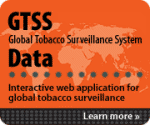Global Tobacco Control
Tobacco use is a major preventable cause of premature death and disease worldwide. Currently, approximately 5.4 million people die each year due to tobacco-related illnesses—a figure expected to increase to more than 8 million a year by 2030. An efficient and systematic surveillance mechanism to monitor the epidemic is one of the essential components of a comprehensive tobacco control program.
CDC is the lead US federal agency for comprehensive tobacco prevention and control, and CDC's Office on Smoking and Health develops, conducts, and supports strategic efforts to protect the public's health from the harmful effects of tobacco use. CDC is a WHO Collaborating Center for Global Tobacco Surveillance and the technical agency for the Global Tobacco Surveillance System (GTSS).
CDC's global tobacco work is supported by the CDC Foundation through donations from the Bloomberg Initiative to Reduce Tobacco Use and The Bill and Melinda Gates Foundation. The priorities of the Global Branch are to:
- Strengthen global tobacco surveillance systems to monitor the global tobacco epidemic
- Increase country and regional capacity to plan, develop, implement, and evaluate comprehensive tobacco control efforts by translating data to action
- Advance research to promote effective tobacco control programs
- Strengthen partnerships to leverage resources for efficient and sustainable tobacco control initiatives
-
Analyzed Data
Surveys, report tables, graphs, and downloadable Microsoft Excel® file. -
Source Data Files
Survey datasets in downloadable Microsoft Access®, SPSS®, SAS®, and STATA® files -
Fact Sheets
Summaries of survey results by survey location and year -
Country Reports
Links to survey reports by survey location and year -
Publications
Published research related to the survey material
GTSSData Surveys
GTSS data are collected from four surveys.
- Global Youth Tobacco Survey (GYTS)
- Global School Personnel Survey (GSPS)
- Global Health Professions Student Survey (GHPSS)
- Global Adult Tobacco Survey (GATS)
GATS Atlas
The GATS Atlas presents tobacco statistics from 22 GATS countries in a visual format—using data that cover nearly 60 percent of the world’s population.
It serves as a resource for decision makers, public health professionals, advocates, researchers, and media as they work to advance social policies.
- Page last reviewed: February 7, 2017
- Page last updated: February 7, 2017
- Content source:


 ShareCompartir
ShareCompartir


